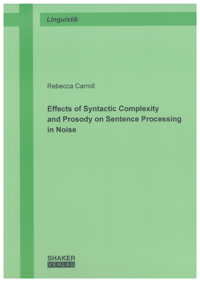
Shop : Details
Shop
Details

July 2013
Rebecca Carroll
Effects of Syntactic Complexity and Prosody on Sentence Processing in Noise
Which processing mechanisms are involved when we listen to sentences in acoustically unfavorable situations such as loud background noise? Answering this question is important for understanding communicative difficulties in hearing impaired populations. Such difficulties may cover a variety of sources. This book systematically investigates the interaction of speech perception in noise, syntactic complexity, as well as the differential influences of noise on the processing of morpho-syntactic and prosodic cues from a psycholinguistic perspective. The investigation comprises of a series of reaction time and electrophysiological studies. The basic assumption is that—at least in German—segmental morpho-syntactic cues such as case, number, and gender marking do not provide reliable information in noise, as they typically occur in prosodically weak and thus perceptually unfavorable positions. Suprasegmental prosodic information such as intonational phrases and phrase boundaries, by contrast, may be more reliable in noise, as they remain available over a longer period of time.
Syntactic complexity is demonstrated to interact with sentence processing in noise. Sentence parts of complex structures that constitute a difficulty on the processor are affected more strongly by a noise masker than easier parts. This finding is related to an additional cognitive strain: The cognitive capacity of individual listeners becomes increasingly important, as resources have to be reallocated. This holds especially for complex sentences which increase the cognitive load, and which are presented in noise: Since the extraction from the speech signal from a noisy background also requires cognitive load (listening effort), the combination leads to a cognitive overload.
Complex sentences that heavily rely on prosodic information for correct interpretation do not seem to be affected by noise as much as sentences relying on segmental morpho-syntactic cues. Although noise slows down processing, it does not interact with the structure of these prosodically disambiguated structures. A prosodic benefit is proposed, in the sense that both the fundamental frequency and the rhythmic structure remain reliable cues in unmodulated, stationary noise. Intonational phrase boundaries may facilitate chunking, which relieves the cognitive load. Electrophysiological evidence supports this assumption.
This psycholinguistic investigation of processing different complex (German) sentence structures relying on different perceptual cues provides a clearer view on the underlying mechanisms and strategies used when processing occurs in acoustically difficult listening situations. Generally, listeners tend to use whatever cues are available for correct interpretation and possibly neglect less important or redundant information. If bottom-up processes become unreliable, top-down processes gain importance. If the latter are misleading (e.g., in case of improbable non-canonical word orders), then comprehension is seriously reduced. The findings presented here have implications not only for current psycholinguistic models of speech perception, but also for the fields of speech audiometry and cognitive hearing research.
Syntactic complexity is demonstrated to interact with sentence processing in noise. Sentence parts of complex structures that constitute a difficulty on the processor are affected more strongly by a noise masker than easier parts. This finding is related to an additional cognitive strain: The cognitive capacity of individual listeners becomes increasingly important, as resources have to be reallocated. This holds especially for complex sentences which increase the cognitive load, and which are presented in noise: Since the extraction from the speech signal from a noisy background also requires cognitive load (listening effort), the combination leads to a cognitive overload.
Complex sentences that heavily rely on prosodic information for correct interpretation do not seem to be affected by noise as much as sentences relying on segmental morpho-syntactic cues. Although noise slows down processing, it does not interact with the structure of these prosodically disambiguated structures. A prosodic benefit is proposed, in the sense that both the fundamental frequency and the rhythmic structure remain reliable cues in unmodulated, stationary noise. Intonational phrase boundaries may facilitate chunking, which relieves the cognitive load. Electrophysiological evidence supports this assumption.
This psycholinguistic investigation of processing different complex (German) sentence structures relying on different perceptual cues provides a clearer view on the underlying mechanisms and strategies used when processing occurs in acoustically difficult listening situations. Generally, listeners tend to use whatever cues are available for correct interpretation and possibly neglect less important or redundant information. If bottom-up processes become unreliable, top-down processes gain importance. If the latter are misleading (e.g., in case of improbable non-canonical word orders), then comprehension is seriously reduced. The findings presented here have implications not only for current psycholinguistic models of speech perception, but also for the fields of speech audiometry and cognitive hearing research.
Keywords: prosody; syntax; cognitive hearing research; speech perception
Available online documents for this title
You need Adobe Reader, to view these files. Here you will find a little help and information for downloading the PDF files.
Please note that the online documents cannot be printed or edited.
Please also see further information at: Help and Information.
Please also see further information at: Help and Information.
| Document |  | Document | ||
| Type |  | |||
| Costs |  | 37,35 € | ||
| Action |  | Purchase in obligation and download the file | ||
| Document |  | Table of contents | ||
| Type |  | |||
| Costs |  | free | ||
| Action |  | Download the file | ||
User settings for registered online customers (online documents)
You can change your address details here and access documents you have already ordered.
User
Not logged in
Export of bibliographic data
Shaker Verlag GmbH
Am Langen Graben 15a
52353 Düren
Germany
Am Langen Graben 15a
52353 Düren
Germany
Mon. - Thurs. 8:00 a.m. to 4:00 p.m.
Fri. 8:00 a.m. to 3:00 p.m.
Fri. 8:00 a.m. to 3:00 p.m.
Contact us. We will be happy to help you.

